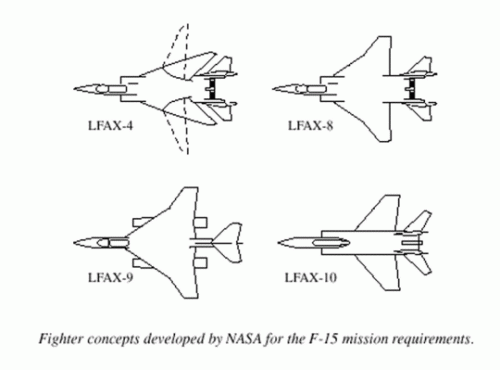I'm kind of curious as to what happened, and when during the FX program. I've heard some information which is kind of conflicting and I'm not exactly sure which one is correct, and some information which just has me confused.
This part I'm pretty sure about
-The FX program starts as a replacement to the F-4 Phantom, multi-role capability, some of the designs have swing-wings (although I'm not sure which), with a max weight of 60,000 lbs. (I'm not sure if the design was to be a twin-seater at this early stage or not)
Pretty sure about this part too...
-USAF/Major Boyd/Pentagon/ after seeing the F-4's less than stellar record in Vietnam realize it's not a good design and the FX would essentially be a replacement to a design they don't want.
Confused about this part
-Major Boyd comes up with a specification for a twin-engined, (I think multi-role) 40,000 lb fighter (when in air-to-air config) with a 1.4 to 1 T/W Ratio, and light wing-loading, to be powered by low-bypass, afterburning turbofan engines.
-Major Boyd comes up with a specification for a single-engined, (I think multi-role) 25,000 lb fighter (when in air-to-air config) design, to be powered by low-bypass, afterburning turbofan engines, inspired by the MiG-21 which had caused a great deal of trouble in Vietnam
-Major Boyd comes up with a specification for a twin-engined, (I think multi-role) 40,000 lb fighter (when in air-to-air config) with a 1.4 to 1 T/W Ratio, and light wing-loading, to be powered by low-bypass, afterburning turbofan engines, then for one reason or another (Perhaps fearing the FX will become another F-4) draws up specifications for a fighter (which I assume is multi-role) with a 25,000 lb single-engined fighter (when in air-to-air config) design, inspired by the MiG-21 which had caused a great-deal of trouble in Vietnam
Confused Here as well
-MiG-25 ends up being mistaken for a superfighter, scares the USAF sh*tless, and the FX-design is revised to meet the MiG-25's performance (at least in terms of speed; Maj. Boyd draws up initial specifications for a 40,000 pound (I'd assume multi-role) fighter (assuming the 25,000 pound single-engine design was the first design cooked up) with a 1.4 to 1 T/W ratio, light-wing loading and MiG-25 top-speed. Airplane to be powered by two 0.6:1 bypass turbofan engines.
-MiG-25 ends up being mistaken for a superfighter, scares the USAF sh*tless, and the FX design is revised to meet the MiG-25's performance (at least in terms of speed); Maj. Boyd centers back on the 2 engined, 40,000 lb (gross-weight/air-to-air weight) design with the 1.4 to 1 T/W ratio and the light wing-loading, but with the MiG-25's top-speed, and the bypass-ratio reduced to 0.6:1 (I remember hearing something about initial specifications being quite broad in regards to the bypass ratio, as high as 1.5 to 1 allowed, but to meet the MiG-25's performance, 0.6 was selected to be the best)
-MiG-25 ends up being mistaken for a superfighter, scares the USAF sh*tless, and the FX design is revised to meet the MiG-25's performance (at least in regards to speed); Maj. Boyd adds the MiG-25 maximum speed requirement to the 40,000 lb fighter twinjet design, and specifies an optimum turbofan bypass-ratio of 0.6 to 1.
Another source of confusion
I saw at least some F-15 drawings which depicted a swing-wing derivative type design. I know the early FX designs were very large and many had swing-wings, but eventually the weights and T/W requirements changed, and the design seemed to change to a fixed-wing design. However, what's confusing is I saw a diagram which showed many studies McD was persuing and it showed looking at swing-wing designs just before selecting the final designs, and personally (out of confusion and lack of information) wonder if the swing-wing was briefly picked up when the MiG-25 max speed was added to the equation to make it easier to reach that speed, then then went back to a fixed wing when they found out they could do the job on a fixed wing.
I'm certainly not trying to "sponge". It's just I've seen various information online, even books about the F-15, and I've got conflicting data in some areas which I listed. I'm wondering which is correct, which is not.
Kendra Lesnick





